Sidi Bouzid, Tunisia (January 26, 2015) – Fusarium oxysporum f. sp. radicis-lycopersici (FORL) is a new emerging pathogen in Tunisia. It causes Fusarium crown and root rot (FCRR) of tomato. Being a new disease, no control methods are available. Therefore, looking for a solution to this pathogen is required. In this study, the efficacy of natural ferti-activator Sanbio PLANTA and synthetic chemical fungicides HYMEXAZOL to suppress FORL was evaluated in vivo under greenhouse conditions.
This project is being carried out within the collaboration between Centre de Recherches Agricoles à Sidi Bouzid, Tunisia and SANBOS GmbH, Germany.
The biological control of FORL by means of Planta SANBIO and its effect on yield, conducted in large-scale greenhouses, is carried out during the 2013-14 season in Hamet Gabès in southern Tunisia.
1. Methods and material
In this study, we used the product Sanbio PLANTA that was mixed with the culture substrate (peat) at a dose of 3 g / liter of peat. Sanbio PLANTA has been tested on the one hand for its stimulatory effect reactions plant defense against Fusarium on root and collar tomato and secondly to see its effect on total crop yield. The pathogen Fusarium oxysporum f. sp. radicis lycopersici (FORL) used in the in vivo control tests was isolated from plants tomato with symptoms of wilt and root rot and crown rot. They were obtained in southern Tunisia where the pathogen has made significant damage.
In laboratory tests, the cultivar ´Riogrande´ is used, while in the Greenhouse control tests on a larger scale , cultivar Bochra , also known for its vis-a-vis sensitivity FORL is retained. The effect of Sanbio PLANTA incidence of Fusarium wilt and root collar is evaluated on tomato plants aged 5 weeks with 5-6 true leaves (Benhamou and Bélanger, 1998). The plants, carefully handled and washed roots are transplanted into pots (12 cm diameter) containing previously disinfected peat.
To test the preventive and curative effect of Sanbio PLANTA, three tests are carried out:
1. the product is applied one week before inoculation with the pathogen
2. processing and inoculation are carried out at the same time
3. the pathogen inoculation is made by a weeks before treatment with Sanbio PLANTA..
The inoculation with the pathogen is achieved by spraying with a spore suspension of (107 spores / ml) in the amount of 10 ml per elementary treatment provided by irrigation level of the crown of the plant. Sanbio PLANTA is applied by mixing the peat with the product due to 3g / liter of peat. The plants thus treated are raised in a glasshouse in a cell temperature of about 23 ° C and a photoperiod of 12 hours. The evaluation of the symptoms is made 30 days after transplantation, based on a rating scale of symptoms, proposed by Vakalounakis and Fragkiadakis (1999) and using the formula Song et al. (2004). Sanbio PLANTA is applied at a dose of 3 g / liter of peat at the nursery on tomato plants cultivar Bochra. The latter, with 3-4 true leaves are transplanted in a multi-chapel greenhouse heated by geothermal water. Transplantation is performed in sausage bags filled with perlite naturally infected in the FORL which was added Sanbio PLANTA at the same dose (3 g / L).
This test is performed with a total of 18,000 plants and the number of wilted plants is noted along the crop year.
In addition to the total number of wilted plants, yield, peas and medium caliber fruits are noted.
Table 1. Product presentation of Sanbio PLANTA
| Product name | Composition | Description | Application |
| Sanbio PLANTA | Activated blend of natural seaweed, nutrients, trace elements, selectively and adapted highly effective natural bacterial cultures and mycorrhiza fungi, activated by SANBIO Biocatalytical Stimulation Technology | Fertilizer and biological activator (certified in France, Germany, EC, USA)Stimulation of plant growth and immunityBetter protection against fungal diseases and biotic and abiotic stressBetter control of factors favorable to plant growthBetter germination and growth of vegetation and development of roots and shootsColonization of roots by beneficial microorganismsBetter mobilization and assimilation of nutrientsEarly flowering and maturationIncreased production and improved quality | Dosage: 1.5 kg / ha in 200-500 l of water No. of application: 1-2 Mode of application: Soil application Stage of application: 3-5 leaf stage |
In this study, we used the fungicide Hymexazol as a reference. Hymexazol was originally introduced by Sankyo. Common names used for this fungicide are hymexazol and hydroxyisoxazole. The fungicide is marketed under the tradename Tachigaren. Hymexazol is distinct from most fungicides with activity against Oomycete fungi in that it is active against certain Aphanomyces spp. Hymexazol is used worldwide as a systemic soil and seed fungicide for the control of diseases caused by Fusarium, Aphanomyces, Pythium, and Corticium spp. in rice, sugarbeet, fodderbeet, vegetables, cucurbits, and ornamentals. Hymexazol fungicide has been applied with a dose of 0.1%.
2. Results
The application of Sanbio PLANTA, a week before inoculation with FORL, has significantly reduced the incidence of Fusarium on root and crown rot of tomato. In Indeed, the results show that the incidence of the disease has not exceeded 10%. Tomato plants which are treated one week before inoculation with FORL have an optimal vegetative growth compared to controls (Figure 1).
Similarly, early application Sanbio PLANTA to the tomato plants has an effect beneficial to the development of the root system compared to controls.

Figure 1: Comparison between a tomato plant not inoculated , untreated (A) and plant treated with Sanbio PLANTA one week before inoculation with FORL (B) after 30 days of rearing at 23 ° C .
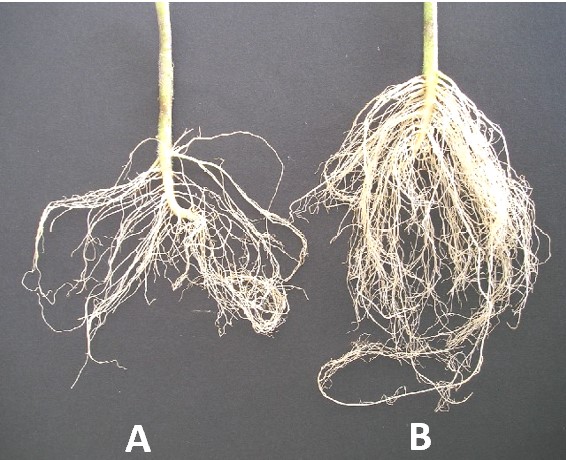
Figure 2: Comparison of the root system of a plant not inoculated and untreated (A) and that of a tomato plant treated with Sanbio PLANTA one week before inoculation by FORL (B) after 30 days of rearing at 23°C.
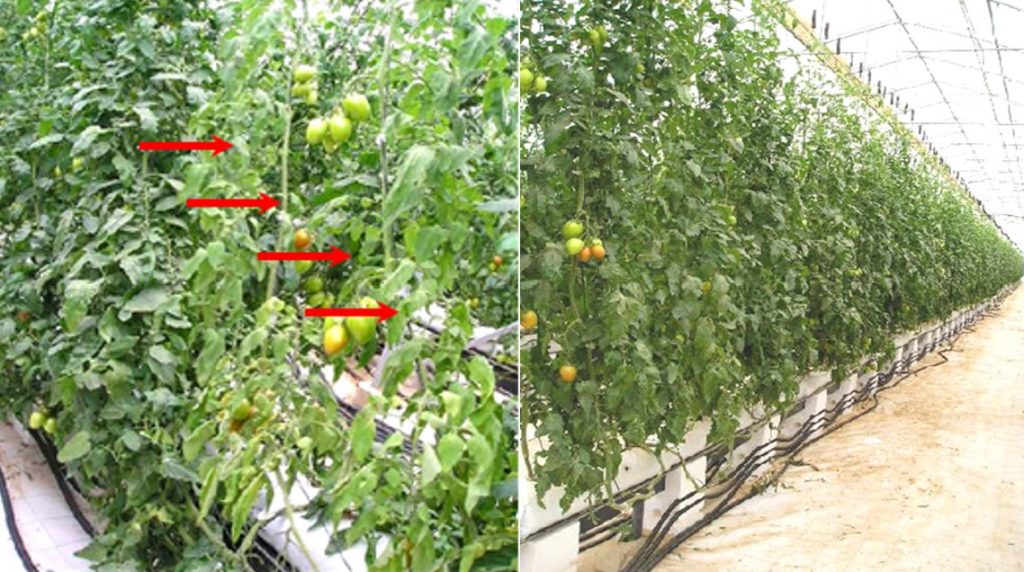
| Figure 3: Comparison of plants treated with synthetic chemical Hymexasol (A) and that of a tomato plant treated with SANBIO PLANTA (B). |
Use of Sanbio PLANTA for a full crop year (September 1st 2013 to 30 May 2014), the total number of wilted plants were only 990 on a total 18,000 plants, a percentage of 5.5%. However, this percentage (5.5%) is far lower in comparing to that measured in the untreated control group when it reached 78%. The reference group treated with Hymexazol achieve 6.4% (Table 2). Percentage and number of wilted plants in the biological control test against FORL large scale.
Table 2: Comparison of number of total plants and withered plants
| Plot | Total number of plants | Number of withered plants | Percentage of withered plants (%) |
| Control, untreated | 500 | 391 | 78.2 |
| Treated with Hymexazol | 18000 | 1152 | 6.4 |
| Treated with Sanbio PLANTA | 18000 | 990 | 5,5 |
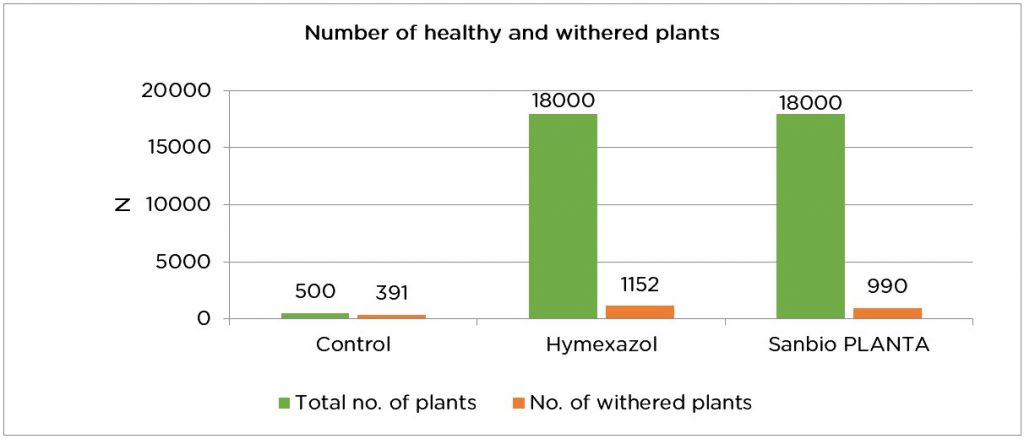
Figure 4. Comparison of number of total plants and withered plants at the plots
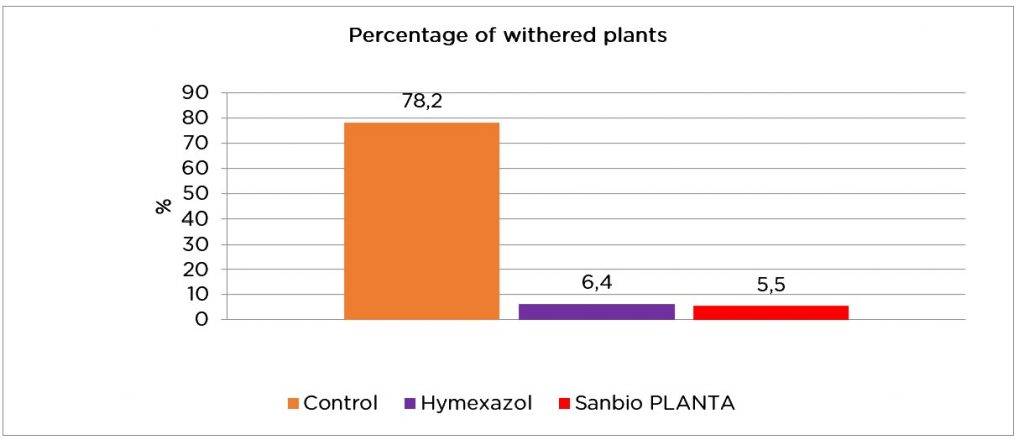
Figure 5. Percentage of withered plants
The yield measurement of the plants treated with Planta SANBIO showed that the latter produced 18 tonnes (an average of 1 kg/plant) more, comparing them to the same number of plants (18,000 plants) treated with Hymexazol. This excess production replaces and even exceeds the losses caused by wilted plants, estimated at 12.87 tonnes (an average of 13 kg/plant). In addition, biologically treated plants showed better fruit quality than those obtained with chemically treated plants, mainly in terms of fruit size (Table 3).
Table 3: Comparison of the total yield, size and average weight of fruit between tomato plants (cv. Bochra) treated with Planta SANBIO and those treated with Hymexazol.
| Plot | Yield kg/plant | Total yield t/plot | Fruit caliber mm | Fruit weight g |
| Control, untreated | 2.8 | 1.4 | 53 | 98 |
| Treated with Hymexazol | 12 | 216 | 52 | 96 |
| Treated with Sanbio PLANTA | 13 | 234 | 55 | 100 |
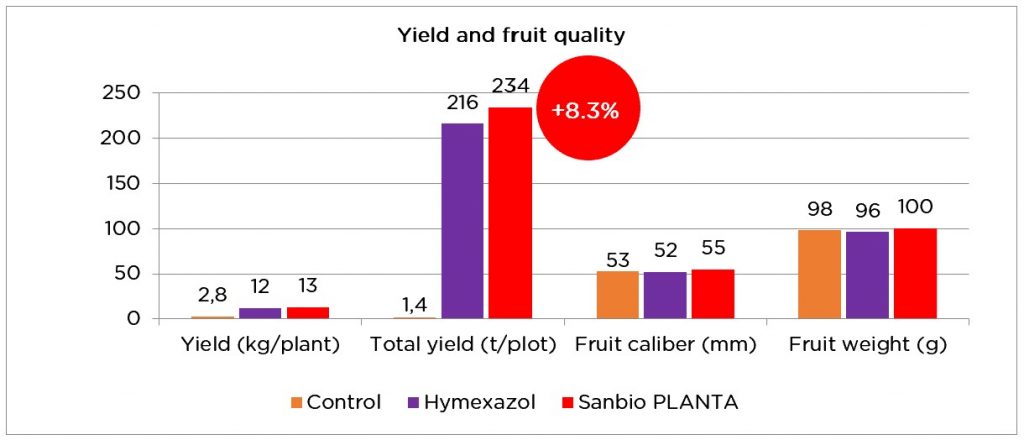
Figure 6. Comparison of the total yield, size and average weight of fruit between tomato plants (cv. Bochra) treated with Planta SANBIO and those treated with Hymexazol.
3. Conclusion
This study showed the effectiveness of Sanbio PLANTA not only in the control of certain soil-based diseases among others FORL (94.5% inhibition) but also in improving yields (+18t more, resp. 8.3% vs. chemical fungicide).